Build your Registry
Learn about how Olyn allows you to create any token format.
Introduction
Olyn Asset Templates provide the developer with the ability to design at a parameter level the requirements needed in order to tokenize an asset at the information level, data precedence, data type, behaviour, etc...
Olyn designed a set of Rules for each information field to be defined, in order to allow developers' freedom and commodity while sharing the template with other team members or users using their service.
At Olyn we designed a gamified framework to allow developers to come up with their own token designs and rules to fulfil each specific use case for each need.

Rules
| Rule Application | Rule Level | Defintion | Observation |
|---|---|---|---|
| Field Name | Field Level | Only allowed certain characters. | characters allowed: [a-zA-Z0-9_] |
| Field Type | Field Level | Field data types are standardized. Only one per definition per field is allowed. | text, number, file, link, location, date or bool |
| Field Behaviour | Field Level | Field behaviour is standardized. Only one per definition per field is allowed. | immutable, replaceable, changeable |
| Is Manual Input | Field Level | Needs to be defined as boolean. | |
| Is Mandatory | Field Level | Needs to be defined as boolean. | |
| Field | Template Level | At least one field needs to be defined in the whole template | isMandatory=True flag needs to be defined. |
| Field Name | Template Level | Key defined needs to be unique per template. |
The Olyn Asset Template is a tool which allows anyone to visualize the possible look of the asset thanks to the rules in each field or block, making it easy to embed a design in any frontend as it's easy to map the design to a screen. Lastly, it also offers a last Validation point when tokenizing assets as it's possible to validate every request to the template requirements (note that Olyn also performs this validation on each request).
Building the asset registry
Deploy an Asset token template with bespoke requirements and attributes for you or others to fulfil.
The Registry is formed into 3 sections,
Asset Data section:
All descriptive information about the asset is located. Data from the asset itself is defined here in order for others to be able to different actions or events that needed to happen in order to tokenize the asset, vs pure information of the asset.
Event Data section:
Validations, events, and webhook information that is needed to make sure the asset is property tokenized, event data is not descriptive information of the assets, but rather needed information to ensure a flow/state/service has been accomplished. Clear examples are payment transaction results, the status of the asset delivery, confirmation of the version used for specific software, etc ...
Informative section:
In order to allow developers to manage their asset templates, they can define some field configurations to identify them easily.
Olyn does not enforce any of this data as it's up to the developer to define them.
| Field | Definition |
|---|---|
| Name | Name of the template to easily locate it. |
| Description | Short description of the template. |
| Version | Version identifier to keep track of template versioning. |
Sharing the asset registry
Once the registry template is defined, Olyn enables the creator of the registry to share the resource with other parties by enabling an external authorization procedure.
This allows other parties or different systems affiliated with the creator of the registry to use the resource and tokenize assets under this registry structure.

Developer flow in order to allow affiliated parties to access the Registry template resource in order to tokenize assets under that framework.
With this feature, developers can granularly give access to affiliated parties to, validate data, register assets under a Registry framework and/or limit the number of registries by authorization. Registry sharing opens up new possibilities for developers to distribute and interact with external services.
Validation of the asset registry
Registry Template offers a validation tool optimized to provide low latency responses which enables developers to verify the verification of each filled field for the registry before requesting tokenization and therefore allows developers to provide assurance on the data provided and can code at execution time against possible errors.

Developers or affiliates can pre-validate fields to provide in-time feedback on their service flows.
Updated about 1 year ago
